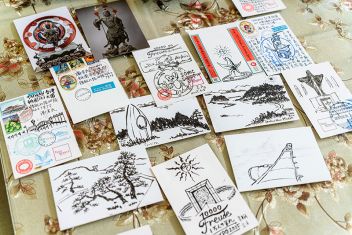
Did you know that Taiwan’s National Greenways—the Raknus Selu Trail, the Tamsui–Kavalan Trails, and the Mountains to Sea National Greenway—are being paired up with paths in other nations to build “friendship trails?” It turns out that trails can build bridges between nations.
A light breeze carries a sprinkling of rain as we read the pair of markers beside the small suspension bridge at the head of the Mingfeng Historic Trail in Shitan Township, Miaoli County. Installed in 2019, the markers commemorate the path’s designation as a Taiwan–South Korea friendship trail. The blue horse-shaped one represents the Jeju Olle Trail on South Korea’s Jeju Island, while the other, with a camphor leaf at its center, represents the Raknus Selu Trail, of which the Mingfeng Historic Trail is a part. Visitors to Jeju Island will find the same markers on Route 15 of the Jeju Olle Trail.
The trailhead of Alishan’s Tefuye Historic Trail is similarly marked. Installed in 2022, the signage memorializes the trail’s “friendship trail” relationship with a greenway on the other side of the world: the Bruce Trail in Ontario, Canada.
Taiwan is also moving forward with another friendship trail arrangement. This one, linking the Tamsui–Kavalan Trails with the Miyagi Olle Trail in Japan’s Miyagi Prefecture, is expected to be finalized in November 2023, with trail markers to go up in May 2024.

Friendship trail agreements are a way to introduce international visitors to Taiwan’s natural beauty and to the cultures and stories of our different ethnic groups.
Historic and cultural trails
“Walking and hiking have gone mainstream in Taiwan over the last ten years.” Chou Sheng-hsin, chief executive director of the Taiwan Thousand Miles Trail Association (TMI Trail), says that since 2018 the Executive Yuan has prioritized making the Tamsui–Kavalan Trails, Raknus Selu Trail, and Mountains to Sea National Greenway into national-class greenways. In addition to exhibiting diverse ecologies, all three of these long-distance trail networks have cultural and historical significance, which makes hiking them a good way for outdoorsy foreign visitors to get to know Taiwan.
TMI Trail, which acts as matchmaker for the friendship trails arrangements, selected the Mingfeng Historic Trail from among the Raknus Selu Trail’s 220 kilometers of primary trails as a partner for South Korea’s Jeju Olle Trail.
The name “Raknus Selu” is made up of the words raknus, meaning “camphor” in the languages of the Saisiyat and Atayal indigenous peoples, and selu, meaning “path” in Hakka. The Mingfeng segment of the trail was originally a Saisiyat hunting trail that Hakka farmers later used to push into and develop the Shitan area. This part of the mountains is woven with paths whose original winding routes through difficult terrain were intended as protection against attacks by Taiwanese Aborigines. Under Japanese colonial rule, these same trails became transit corridors for camphor and tea. Hiking them in the present day is a way to explore the history of Taiwan’s ethnicities and its economic development. When hikers reach the trail’s end, they can cool off with a cup of grass-jelly tea in Shitan’s old town and then continue their historical explorations with a tour of the Shitan Presbyterian Church, which was built in 1873. A longan tree near the church marks the spot where George Mackay, the famed Presbyterian missionary, used to pull decayed teeth for locals. At the end of the day, the hike not only delivers an array of ecological wonders, but also a rich historical and cultural experience.
A preordained marriage
The friendship trail arrangement between the Tefuye and Bruce Trails was the end product of a long and arduous search.
Hikers traveling the Tefuye Historic Trail, which is part of the Mountains to Sea National Greenway, should also check out the nearby Tefuya Trail, leading to the Tsou indigenous communities of Tapangu and Tfuya (Chinese names Dabang and Tefuye). Legend says that these two places are the footprints of the sky god. The Tefuye Historic Trail was once a Tsou hunting trail, which the Japanese transformed into the Shanshui Rail Line and used to transport timber. Those hiking it today can enjoy the misty alpine ambience along with the cultural atmosphere of an Aboriginal village and forest railway.
Chou Sheng-hsin says that the Tefuye Historic Trail retains some of the old rail line’s tracks, ties, and bridges, as well as lush flora that includes Japanese cedar (Cryptomeria japonica), stumps of felled Taiwan red cypress (Chamaecyparis formosensis), abundant ferns, Taiwan sassafras (Sassafras randaiense, an endemic relict species that is one of only three extant sassafras species in the world), wheel tree (Trochodendron aralioides, another relict species), and love apple (Paris polyphylla), which appears on the back of the present-day NT$1,000 bill.
The Bruce Trail’s friendship arrangement with Tefuye involves the Bruce Trail’s second section, which stretches ten kilometers from Smokey Hollow in Hamilton to City View Park in Burlington. It follows a dirt path, a gravel trail, a former horseracing track, and a surface street, passing through varied terrain that includes a waterfall, a canyon, forest, grassland, and the McNally Protected Natural Area. It’s a beautiful hike that should be on the shortlist of places to visit for Taiwanese traveling to southern Ontario.

Hikers along the Tamsui–Kavalan Trails will find trail markers emblazoned with a representation of Dipteris conjugata, a relict fern species.
Using trails to be heard
Global advocacy for international friendship trails began with South Korea’s Jeju Olle Trail. “The island of Jeju used the Jeju Olle Trail to put itself on the map.” Chou Sheng-hsin explains that Jeju is an outlying island that people from elsewhere used to think of as little more than a place with casinos and golf courses, and as a honeymoon destination.
Suh Myung Sook, the originator of the friendship trails concept, changed that. Feeling exhausted by a lifetime of work, she made a pilgrimage along Spain’s Camino de Santiago. After returning home to Jeju with a renewed sense of happiness and purpose, she set about linking up various short trails passing through the beautiful island’s forests, fields, pastures and villages into what ultimately became the 425 kilometers of the Olle Trail. In the years since, the annual Jeju Olle Walking Festival has become a major event that has revitalized the local tourism industry and the wider economy.
Promoting peace and friendship
In 2022, Taiwan hosted the fourth annual Asia Trails Conference. In a prerecorded presentation, Suh shared that Japanese tourism businesses had asked the Jeju Olle Foundation to help them develop trails in Japan to help revitalize the Japanese tourism industry, which is still suffering from the impacts of 2011’s Tohoku Earthquake and Tsunami. Suh said she was surprised when one of the foundation’s board members opposed the effort because of the historical conflicts between the two nations, but that after much internal wrangling the group eventually agreed to help.
When Korean hikers visit Kyushu, Japan, they interact with locals, which increases mutual understanding. This is not only changing old Korean stereotypes about Japan, but also resulted in Japanese proactively getting in touch with Koreans to express concern and support in the wake of the Seoul Halloween crowd crush in 2022. “If you have a ‘path,’ you can interact, which is the only way to increase understanding,” says Suh. “These trails are a great way to ease regional and national tensions and conflicts.”

Hiking a trail is a complete sensory experience that introduces travelers to local history and culture as well as the local ecosystem. It’s also environmentally friendly!
Stimulating the economy
To further spur tourism, the Miyagi Prefectural Assembly sought cooperation with Taiwan as well, resulting in the assembly signing a letter of intent with Taiwan’s Tourism Bureau in April 2023.
Given the already friendly relations between Taiwan and Japan, each side was able to immediately suggest four trails to link up as friendship trails. TMI Trail played the role of matchmaker, pairing Northeast Taiwan’s Caoling Historic Trail with Kesennuma’s Karakuwa Trail; the hiking and hot springs of Yilan’s Paoma Historic Trail with Osaki’s Naruko Hot Spring Trail; the Jinzibei Historic Trail with the Oku–Matsushima Trail; and Keelung’s Nuandong Valley Trail with the Tome Trail.
The Nuandong Valley Trail is a segment of the central Tamsui–Kavalan trail complex, which was once crucial to the commercial transportation of goods into Keelung’s Nuannuan District. In those days, Nuannuan was the terminus of the northern and central Tamsui–Kavalan Trails, and Northern Taiwan’s export hub for coal, tea leaves, and the raw materials used to make indigo dye. The Jinzibei Historic Trail, which runs from Houdong to Sandiaojiao in New Taipei City, is another segment of the Tamsui–Kavalan trail complex. Still retaining many traces of its history, the present-day trail charms hikers with a sense of what the Tamsui–Kavalan Trails must have been like 200 years ago.
Dipteris conjugata, a relict fern species, still abounds all along the Tamsui–Kavalan Trails. Businesses along the trails have proved similarly resilient, making creative use of local ingredients such as pumpkin and white ginger lily to create specialty dishes and boxed meals, and also selling local creative and cultural products.
On one of the visits that members of the Miyagi Prefectural Assembly made to the Paoma Historic Trail, they came across Chinese hibiscus in a valley, and their guide told them that they could suck out the flowers’ nectar. Assembly member Shuya Takahashi was reminded of doing that as a boy in Japan, and said he never imagined that he would have such a nostalgic experience in Taiwan so many years later. It’s no wonder he says that his visits to Taiwan feel like coming home!
Traveling on foot offers a deeper experience than any other form of tourism, while also being the most environmentally sustainable.
So come hike Taiwan’s trails! You’ll experience Taiwanese life and culture at first hand, and see a different side of our island!
For more pictures, please click 《Walking to Global Ties: International Friendship Trails》











